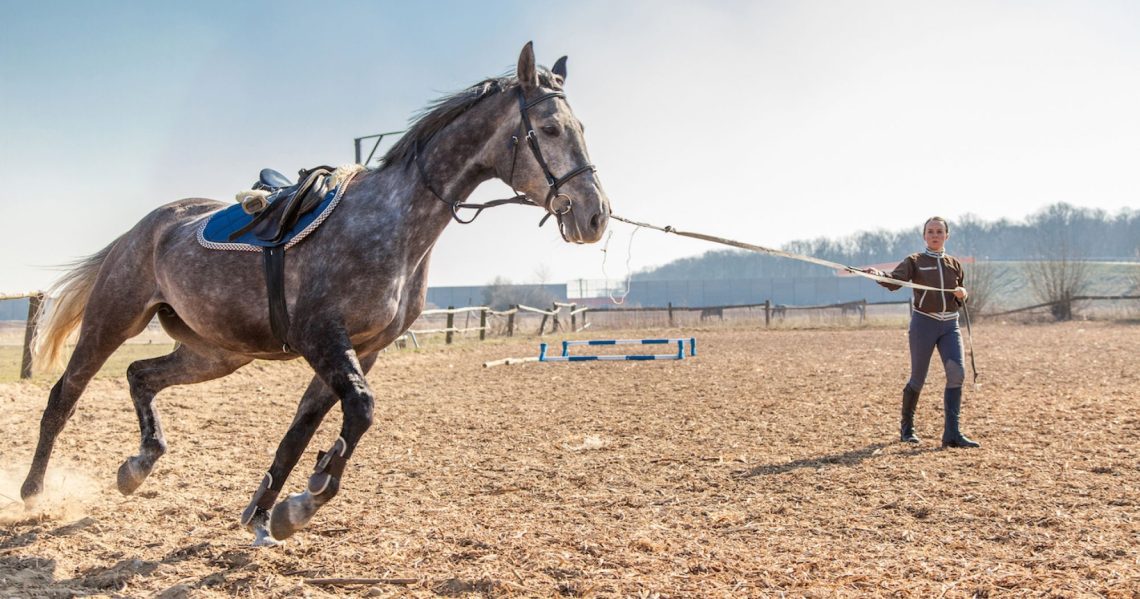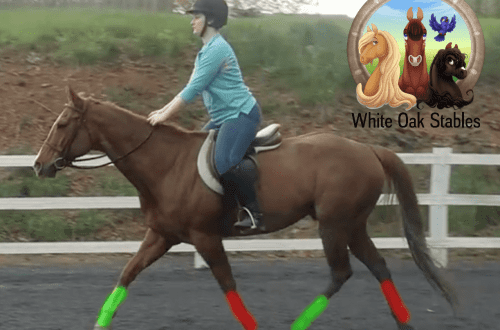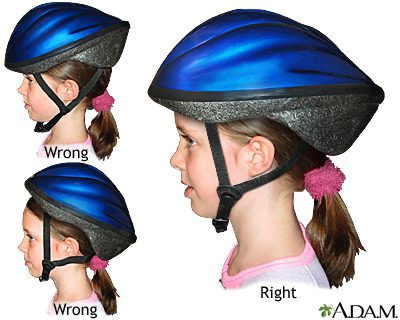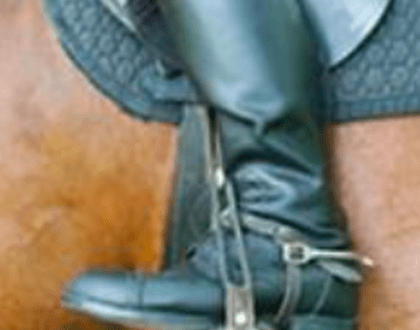
Health training: exercises that improve the horse’s fitness
Health training: exercises that improve the horse’s fitness
As owners, trainers and riders, we are responsible for all aspects of the health and well-being of our horses, which includes ensuring adequate preparation for the work that the horse will do next. Good physical condition allows the horse to perform to the best of his ability and reduces his susceptibility to injury.
Working with a horse includes not only its direct training, but also control over its diet and rest. This article is all about exercise and rest, but remember that the diet must be adjusted according to the horse’s workload and body condition.
Physical fitness improves when the horse regularly (!) gets enough exercise. Intensive work on the exercises leads to minor tissue damage, which is restored over the next couple of days. Repeated cycles of tissue damage during exercise and the subsequent recovery process result in a horse that is more resilient and stronger.
One of the most important concepts in fitness is the need for tissue regeneration between workouts, which means that we should alternate between workouts and recovery days during which tissues are repaired and strengthened. Repeating the same type of work day in and day out creates a situation where tissue damage outpaces tissue repair, and this is what causes re-injury (eg, tendon problems). Ideally, heavy training should be done at intervals of 1-2 days, during which the horse will perform various types of other exercises. It is important that the day of recovery is not a day of “standing in the stall”! The horse has to do a different type of work that will affect other parts of his body.
The most important component of success is the ground on which the horse works. We should aim for horses to be able to perform “slow” work on a variety of terrain and types of terrain to provide their musculoskeletal system with a variety of challenges. On the other hand, “quick” work and training should take place on good, predictable ground.
Loads should be specific and depend on the discipline or type of work the horse is doing. If you are in triathlon, it is inappropriate to work only in trot and canter. You need a good canter that will help develop muscle and strengthen the cardiovascular system to the level that you need for cross-country.
Thus, you will first need to decide on your training goals in order to determine the type, intensity, and duration of exercise needed to develop a successful program. If you have a target date by which your horse was maxed out, use that as a guide to determine when to start training based on increasing your workload by 5-10 minutes per week. If the demands of your sport involve certain skills, such as jumping over hurdles, take an extra month or so to strengthen the relevant muscles in your horse.
If your horse returns to work after a break, be sure to pay attention to the condition of his legs and teeth, and check if the saddle fits him before starting the training program. If the horse is not shod, it may need to be shod before being taken out onto hard, unfamiliar ground. As soon as she gets comfortable on it, the horseshoes can be removed. Check how long it has been since her teeth were treated. Have a veterinarian check them if necessary. Is the saddle suitable for the horse? You will need to reevaluate this as your back muscles may have changed.
We’ll consider three areas of training that deal with the different physiological aspects of preparing a horse for sporting demands: cardiovascular system, muscle strength and elasticity. Although we will be talking about tournament horses, the same principles of preparation apply to non-competing horses.
The three areas we are developing that deal with the different physiological aspects of horse training include muscle strength, which we work on while doing gymnastic jumps.
The cardiovascular system
Cardiovascular fitness allows the horse to do his regular work without getting tired. Cardiovascular training enhances the process by which energy from food is converted into energy that fuels muscles during movement. It also promotes more efficient dispersal by the body heat that builds up in the muscles during sports activities. Horses show measurable improvements in cardiovascular health after just two weeks of regular exercise.
An easy way to develop an appropriate training program is to make a video of the competition at the same level that you want to compete. When you play the video, you can see how long the horse has been cantering, trotting, cantering, walking, and how long it has been moving at different speeds. This information is used to develop a training plan that will help you bring your horse to the required level of fitness. The working periods of the training will coincide with those in the sport.
Horses that compete in dressage competition at the entry levels must be able to work under the rider for 45-60 minutes at walk, trot and canter. Horses that participate in more “strength” sports such as eventing and show jumping must be physically prepared specifically for those activities, given that the fitness requirements are primarily endurance or speed related.
The amount of work performed is negotiated in terms of intensity (how hard the horse works), duration (how long the horse works), and frequency (how often the training is repeated). The key to getting fit while staying healthy is finding the right balance between these three elements.
When the goal is to improve the cardiovascular system, the appropriate frequency of training should be two to four times a week, but not in a row, so that the tissues have enough time to recover and regenerate between loads. Once the desired level of fitness is reached, a few workouts per week will be enough to keep the horse in shape, but if the horse is working less than twice a week, he is likely to lose shape.
Cardiovascular improvement is achieved by increasing the intensity or duration of exercise on a weekly basis. Resist the temptation to increase both intensity and duration at the same time. This way you run the risk of overloading the tissues and injuring the horse. Endurance sports, including triathlon, are activities in which a horse works at low to moderate intensity for periods ranging from a few minutes to many hours. Horses competing in endurance sports are prepared by relatively long sessions at moderate speeds, often involving short bursts at higher speeds. In order to improve the cardiovascular system of these horses, the duration of exercise is increased by about 10 minutes per week, the intensity of exercise is kept constant.
For horses competing in competitions based on their sprinting ability, including show jumping, interval training is used in which the horse works at high speed or intensity for a short time and then walks or trots for a recovery period that five to six times longer than the working one. During the recovery period, lactic acid is removed from the muscles and the heart rate decreases. The horse then performs another high-speed work followed by a recovery interval. The gap between “short” loads allows the horse to perform more total work with less risk of injury. In order to improve the cardiovascular system of horses participating in power or speed competitions, it is advisable to increase the intensity of exercise weekly while maintaining the same duration. Increasing intensity involves working at a higher speed.
Another way to increase the training stimulus is to add a new type of exercise to the training regimen, such as slope work and jumping. Introduce new exercises gradually, and then gradually increase their intensity or duration as needed. Cantering uphill greatly increases the workload and is a great way to improve the horse’s fitness without overburdening the limbs. But note that when driving down the slope the limbs are stressed by hitting the ground, so it is recommended that horses walk downhill.
The cardiovascular system improves when cantering up slopes.
Gaoping up slopes improves the horse’s cardiovascular system through a significantly increased workload. Cantering or walking up also makes the horse stronger and more enduring because the horse’s hindquarters have to work harder. Note the engagement of this horse’s hindquarters (left) as it moves up the slope. Walking downhill (right) when the horse is self-carried and not resting on the reins promotes better flexion of the hind leg joints and activates the muscles that lift the withers.
The horse’s workload is gradually increased until his level of fitness is somewhat above the requirements of the competition. If the level of fitness of the horse exceeds the level that will be required at the tournament, then your horse will have a kind of reserve of strength if the situation turns out to be more difficult than expected (it will be hot, humid weather, the ground will be sticky, etc.).
Power training
Strength training is aimed at developing locomotor muscles in the neck, back and limbs. Strength training is especially useful for horses that need to perform jumps that require explosive bursts of muscle strength, as well as move collections that require endurance muscles to help the hindquarters take weight and lift the withers. Strength training also protects horses from injury by developing and strengthening the muscles that stabilize joints, especially when they are loaded in unusual or unexpected ways (for example, if the horse stumbles or steps into a hole).
Muscles are made up of slow-twitch and fast-twitch fibers that are specialized for different types of activity. In representatives of different breeds, and simply in different horses, the ratios of different types of fibers in the muscles differ. Slow twitch fibers are resistant to fatigue; they contract repeatedly over several hours, which is beneficial during endurance competitions. In horses dominated by slow twitch muscle fibers, the muscles are flatter. (These are well-trained Arabian horses). Fast twitch fibers provide power and speed during accelerations, jumps and jumps. When we work to increase the musculature of a horse with a high percentage of fast twitch fibers, its muscles look bulky, like a quarter horse (quarter mile racehorse).
People use various exercises to strengthen specific muscle groups, both with and without machines and equipment. In the case of horses, weights can also be used, but this method has the disadvantage that it increases the load on the limbs, which increases the risk of injury. Therefore, we must be innovators in the development of strength training for horses that develops the appropriate muscles without increasing the risk of injury. This can be achieved through hill work and gymnastic jumping.
Gymnastic jumping is another way to build muscle. During repulsion, the muscles of the back develop, and during landing, the muscles that raise the withers.
As the horse moves up the slope, the moving muscles in the hindquarters must work harder. Steep inclines are especially valuable for strength training and should be done at a walk or canter, not a trot. This way you can avoid injury to the area around the sacroiliac joint. As with all types of training, start with low reps and increase either the number of reps (duration) or the speed (intensity) at which they are performed weekly.
As the horse moves down, the workload is reduced, but the stress on the limbs is increased, so the descent must be done at a walk. When a horse descends a steep slope, carrying himself without relying on the rider’s hand, his hocks and knees flex, and the muscles that raise the withers are activated. In this way we train the muscles that are used during the collection. Particularly useful will be work at a slow pace, including frequent stops and even reins.
Jumping over obstacles will also be useful. Especially useful will be repeated repulsions and landings when working in rows. Jumping should only be used for strength training if the horse is good at jumping. A horse that has poor overcoming technique (such as a sagging back) will not benefit from using jumping as a strength development technique.
A highly professional method of strength training is the repetition of a movement that is part of an athletic performance and that requires muscle effort. For example, jumping or piaffe in an interval training program. You alternate repetitions of the movement with light recovery periods at the walk or trot, then increase the number of repetitions each week to stimulate the strengthening of those muscles. The key is doing the movements with good technique (this is how the right muscles are recruited and developed). Stop the exercise if your horse shows signs of fatigue, which means the wrong muscles are being used.
Another important type of strength training for horses is core work, which focuses on the muscles that move and stabilize the back. Carrot stretches are a valuable form of core training.
It has been proven that with its help we strengthen the muscles that protect the back from injury. The horse learns to follow the treat (like a piece of carrot) with its nose. Performing an exercise that rounds the back, the horse stretches its nose to the chest, between the carpal joints, between the fetlock joints.
Flexion exercises – the horse stretches nose to the shoulder, to the girth area, to the groin on each side. Ideally, each position should be held for five seconds before giving the horse a treat. It is advisable to perform three to five repetitions daily.
The horse is pulled nose down to the chest, between the carpal joints or between the hip joints. An exercise to round the topline.
Flexibility
A flexible horse is in control of his joints, they move smoothly and over a considerable range. Flexibility exercises primarily target the joints of the neck, back, and upper limbs. In addition to strengthening the core muscles, carrot stretches also increase elasticity by moving the back and neck through their full range of motion while standing, which cannot be done when the horse is in motion.
Under the saddle, elasticity is developed through movements that require the horse to round and flex. When we work in a spiral, narrowing and widening the circle, we improve the flexibility of the horse, because he contracts more and more muscles on the inside of the body and stretches on the outside when he narrows the circle. Changes in circle size teach the horse to regulate muscle tension in a smooth and coordinated manner. Over time, as flexibility and muscle strength develop, the circle can be narrowed even more.
Lateral movements such as shoulder in, shoulder out, hip in, hip out, half in and sideways are also helpful in improving back and neck elasticity.
Increases in the range of motion of the limbs (forward and backward and side to side) are improved when working in turns, working on lateral movements and when changing stride length. In turns and when moving in a circle, the outer limb should move in a longer arc. Lengthening and shortening the stride in large circles develops freedom of shoulder movement. Lateral movements improve elasticity in the upper limbs as they alternately move away from the body and across the body. Be sure to do the exercises both to the left and to the right.
Strengthening a horse is an ongoing process that requires frequent determination of his fitness level and comparing it with the fitness level required for the work and exercise he is doing. So we can be sure that the horse does not risk health and works to the best of its ability.
After training, in order to strengthen the physical condition, we must allow the horse to cool down and relax his muscles. Departure to nature, in a field or forest is a good option.
Basic principles of training:
Improving a horse’s fitness is an ongoing process that requires regularly measuring his fitness level and comparing it to the fitness level required for the work and exercises he does.
Hilary Clayton, BVMS, PHD, MRCVS, DACVSMR (source); translation Valeria Smirnova.





